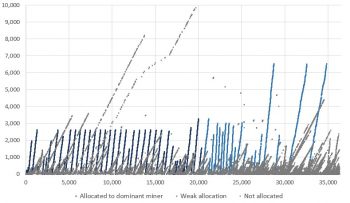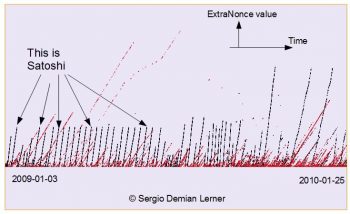On August 20, 2018, Bitcoin Mercantile Exchange (BitMEX) published research on a quintessential question bounced around since Bitcoin’s introduction in 2009: Does Satoshi Nakamoto own a million bitcoins?
A Million or not a Million
BitMEX based its study on Sergio Demian Lerner’s 2013 analysis, where the developer uncovered mined Bitcoin blocks can be traced back to their miner, proving the pioneer cryptocurrency was technically anonymously, yet behaviorally pseudo-anonymous.
Referring to his analysis, the exchange noted that while evidence of Nakamoto, Bitcoin’s creator and first miner, is thin, there is ample data to support that a single miner generated over 700,000 bitcoins after the protocol’s release.
The exchange posted a worthwhile graph of all Bitcoin blocks mined in 2009, with block height on the y-axis and “ExtraNonce” on the x-axis.
For the uninitiated, “Nonce” is a block hashing algorithm enclosed in 32-bit memory containing the hash values of the network. A change in Nonce leads to a change in the output block hash.
Further, if the Nonce fails to achieve the block hashing target, an “ExtraNonce” algorithm is in place to help miners change block values and recalculate hash power.

(Source: BitMEX Research)
As seen in the above graph, blockchain enthusiast and researcher Lerner argued that Nakamoto possesses over one million bitcoins. He reasoned this claim citing the low hashrate, about seven million hashes per second, when Bitcoin was initially released, and that only one miner was dominating the network for the first 14 days.
Community Unimpressed
The crypto-community disregarded his claims, citing three firmly-held opinions:
- No evidence or reason to believe only Nakamoto mined Bitcoin for 14 days.
- Several other crypto-enthusiasts claimed to have mined the network in the time frame.
- Incorrect hardware specifications pointed out in Lerner’s research.
- 7MH/s estimate being unreliable and no sizeable sample-set present to validate this.
A few individuals also stated if Nakamoto indeed mined a significant amount of bitcoin, the network’s “monetary integrity” would have been negatively affected.
However, Lerner then posted stronger evidence for his case, making several naysayers accept the premise of a single miner dominating a large part of the network during its initial days. Once again, Lerner focused on ExtraNonce values to estimate the Coinbase transactions, as shown in a merkle tree diagram posted on his blog.
In addition, the researcher published the below picture to demonstrate all black lines belonged to a single miner – who controlled over a million bitcoin.

(Source: Bitslog)
BitMEX Steps in
BitMEX attempted to repeat and validate Lerner’s research methodology, changing some aspects to fit with their objective of counting all blocks mined by the singular entity and then allocating blocks. The exchange noted the “challenging” nature of the experiment, stating “it is impossible to do an accurate allocation.”
With the aforementioned in mind, the exchange proceeded to present its rendition of Lerner’s research, allocating each block to different ExtraNonces and conduct anecdotal analysis.

(Source: BitMEX Research)
Based on the graph, the exchange “agreed” with Lerner’s results in August 2009, citing the similar block heights and gradients as belonging to one miner, alongside the rather uncanny non-overlapping slopes.
After August 2009, the slope patterns become wayward, and gradients differ considerably, with even the block heights and block time gaining inconsistency. However, the exchange stated such data values do no confirm the initial mining activity was just one entity.
Refuting Claims
BitMEX stated while the graph was “compelling” and presented a clear case for validating Lerner’s claims, similar results could be obtained by a few miners using similar setups for mining before other entities joined the network with more powerful systems.
The exchange reported:
“In conclusion, although there is strong evidence of a dominant miner in 2009, we think the evidence is far less robust than many have assumed. Although a picture is worth a thousand words, sometimes pictures can be a little misleading.”
The research further added the single entity, even if it were Nakamoto, generated much less than a million bitcoins, pegging the figure closer to 600,000 or 700,000 BTC.
“None of the above says much about whether the dominant miner was Satoshi,” concluded BitMEX, adding “although we know Satoshi mined block 9, which we have allocated to the dominant miner in our analysis. “







